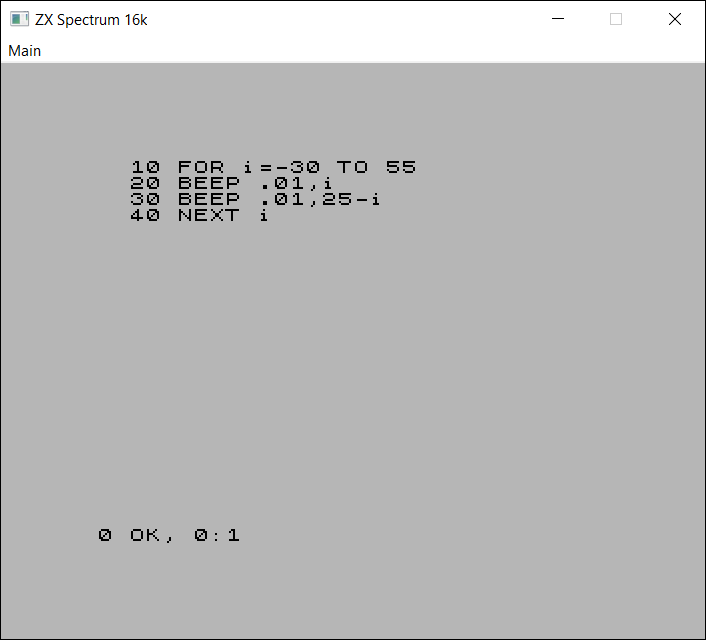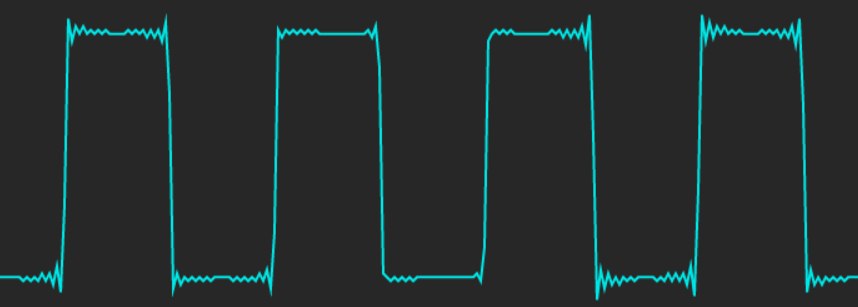Tutorial
How to build your own emulator with the SPECTRUSTY library.
This project is maintained by royaltm
SPECTRUSTY Tutorial
This is a part of the tutorial for the SPECTRUSTY library.
In this step, you can learn how to make your emulator emit sound.

Step 2 - Buzz on
Wouldn’t it be nice if your Spectrum could at least BEEP and make some keystroke noises?
Unfortunately, synthesizing and playing the audio stream isn’t very easy. That’s why this whole step is solely dedicated to making your emulator go beep buzz beep.
There are some challenges involved:
- First, we need to produce some audio samples from data collected while running a single loop iteration.
- Next, we need to seamlessly stream those samples into the audio output device.
Let’s now focus on the first challenge.
If you understand the first challenge, just skip the following 4 paragraphs and go straight to the solution.
Bare ZX Spectrum produces sound by alternating the voltage on its EAR and MIC output lines. Only two states are possible: high or low. If this state is changing fast enough, we could hear some tone. But the shape of such a sound wave is not the natural sinusoid but instead is square.
The perfect square wave can be represented as an infinite sum of sinusoidal waves. The problem (definitely oversimplified here) is that the frequency of those waves tends to infinity. The digitized sound is limited by the finite sample frequency. The maximum frequency that can be sampled is called the Nyquist frequency, which is half of the sampling frequency - usually at around 22kHZ (upper human hearing ability limit).
When the emulator runs, the changes to the EAR and MIC states are recorded as timestamps. The frequency of the CPU clock is around 3.5 MHz. That is around 79 (3_500_000 / 44100) times more than the typical audio sample frequency. We have to somehow downscale the frequency without losing the sound quality. Digitized square waves that sound clear should be constructed from a limited number of sinusoidal waves. The computation of such waves would be costly.
Fortunately, audio engineers have noticed that the pattern of the square steps is independent of the sampling frequency. Thus, it should be easy to pre-calculate this pattern and apply it to the stepping changes, with a little bit of scaling. This technique is called Hard sync.
The solution is a Bandwidth-Limited Pulse Buffer (BLEP). If you want to know the details, don’t hesitate to read an excellent sync tutorial.
Synthesizing

With SPECTRUSTY to generate audio samples, follow these steps for each frame:
- add some amplitude steps to the
BLEPthat correspond to theEAR/MICline changes (or other sources), - finalize the
BLEPframe, - render the
BLEPframe as audio samples, - prepare the
BLEPfor the next frame.
For the sake of flexibility, sample steps are added via Blep trait. Different BLEP implementations can be used this way. In the spectrusty-audio, there is one such implementation out of the box.
Let’s now adapt your emulator:
First, we need to enable the audio feature to access the audio::synth module in Cargo.toml:
[dependencies]
spectrusty = { version = "0.1", features = ["audio"] }
then to your program:
// Yasss... more imports coming your way...
use spectrusty::audio::{
Blep, AudioFrame, EarMicOutAudioFrame,
AudioSample, FromSample, EarMicAmps4,
synth::BandLimited
};
// the type of the Blep implementation amplitude delta
type BlepDelta = f32; // i16 or i32 can be also used instead
fn main() -> Result<()> {
//... ✂
//... later in main
// first let's get an instance of some audio device implementation
let audio = create_audio();
// second the Bandwidth-Limited Pulse Buffer implementation with
// a single channel
let mut blep = BandLimited::<BlepDelta>::new(1);
// we need a sample frequency of the audio output
let sample_rate: u32 = audio.sample_rate().into();
// ensure the Blep implementation is prepared for pulses
spectrum.ula.ensure_audio_frame_time(&mut blep, sample_rate);
//... ✂
}
fn run<C: Cpu, M: ZxMemory>(
spectrum: &mut ZxSpectrum<C, M>,
env: HostEnvironment,
) -> Result<Action>
{
let HostEnvironment { audio, blep, border, ... } = env;
let (width, height) = <UlaPAL<M> as Video>::render_size_pixels(border);
//... ✂
while is_running() {
spectrum.update_keyboard( update_keys );
spectrum.run_frame();
let (video_buffer, pitch) = acquire_video_buffer(width, height);
spectrum.render_video::<SpectrumPalRGB24>(
video_buffer, pitch, border);
// (1) and (2)
spectrum.render_audio(&mut blep);
update_display();
// (3) render the BLEP frame as audio samples
produce_audio_frame(
audio.channels(), audio.frame_buffer(), &mut blep);
// somehow play the rendered buffer
audio.play_frame()?;
// (4) prepare the BLEP for the next frame.
blep.next_frame();
//... ✂
}
Ok(Action::Exit)
}
Let’s look closer at the steps 1 and 2:
impl<C: Cpu, M: ZxMemory> ZxSpectrum<C, M> {
// a generic function that will accept any Blep implementation
fn render_audio<B: Blep<SampleDelta=BlepDelta>>(
&mut self,
blep: &mut B
) -> usize
{
// (1) add some amplitude steps to the BLEP that correspond to
// the EAR/MIC line changes
self.ula.render_earmic_out_audio_frame::<EarMicAmps4<BlepDelta>>(
blep,
0);
// (2) finalize the BLEP frame
self.ula.end_audio_frame(blep)
}
}
EarMicAmps4 is an implementation of AmpLevels trait. This trait is responsible for translating the digital audio levels to the sample amplitudes. In case there are more than 2 levels, their corresponding amplitudes should scale exponentially.
We can interpret EAR and MIC lines as 4 digital levels:
EAR MIC level
0 0 0
0 1 1
1 0 2
1 1 3
And that is exactly what EarMicOutAudioFrame::render_earmic_out_audio_frame method does. If you only want to hear the EAR changes and ignore the MIC changes, you can replace EarMicAmps4 with EarOutAmps4.
Now, step 3. In this example, we assume the audio object is capable of providing an audio buffer as a vector of audio samples T:
fn produce_audio_frame<T: AudioSample + FromSample<BlepDelta>>(
output_channels: usize,
outbuf: &mut Vec<T>,
blep: &mut BandLim
)
{
// the BLEP buffer summing iterator of the channel 0
let sample_iter = blep.sum_iter::<T>(0);
// the number of samples that the iterator will generate
let frame_sample_count = sample_iter.len();
// ensure the size of the audio frame buffer is exactly as we need it
outbuf.resize(frame_sample_count * output_channels, T::silence());
// render each sample
for (chans, sample) in outbuf.chunks_mut(output_channels)
.zip(sample_iter)
{
// write sample to each channel
for p in chans.iter_mut() {
*p = sample;
}
}
}
The generic audio sample type T may be different from the BlepDelta as long as it can be converted from BlepDelta with the FromSample trait.
In step 4, the method next_frame is called on the blep object.
That basically covers the topic of creating audio samples.
Streaming
How to play audio seamlessly is another cookie to crunch.
Most of the audio frameworks usually spawn a dedicated thread that periodically calls your function to fill the output buffer just in time to be played. To our emulator’s loop, this is a completely asynchronous process.
To overcome this hurdle, Spectrusty introduces the Carousel. It consists of an interconnected pair of an audio producer and a consumer. The consumer lives in the audio thread. The producer is available in our loop. The producer can send the audio frame buffer of the arbitrary size to the consumer and the consumer when called by the audio framework fills the audio output buffer with our audio frame data and then sends it back to be filled again. We can control how many buffers are in the circulation thus influencing the latency and stability of the sound playback stream.
To simplify this task there are some platform-specific features that can be enabled:
[dependencies]
spectrusty = { version = "0.1", features = ["audio", "cpal"] } # or "sdl2"
providing the complete carousel solutions for cpal audio layer or SDL2.
I won’t go into details on how to implement the carousel for any particular framework, because a quick look to the spectrusty-audio::host should reveal all its secrets.
Example
The example program using minifb and cpal, covering the scope of this tutorial can be run with:
cargo run --bin step2 --release
Next
Step 3 - R Tape loading error.
Back to index.